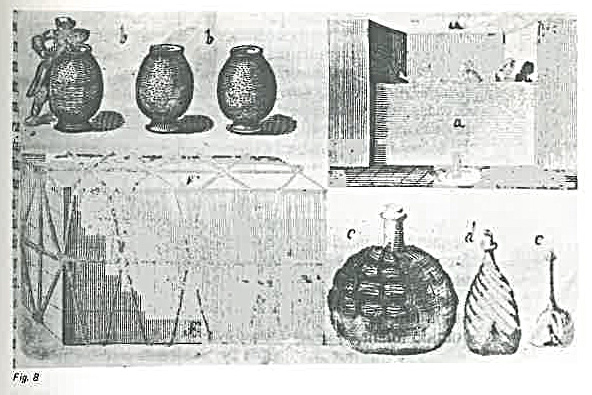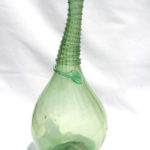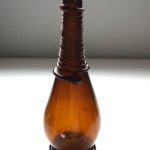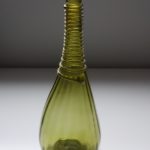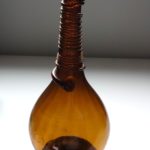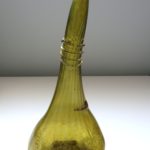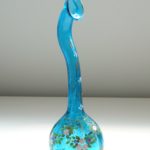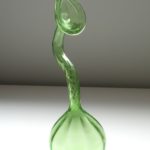Exotic Entertaining information[1]
Booklet II
Eighth Relation
Wine-making in Shiraz[2] (region)
Paragraph 1
Having visited the antiquities, I would leave[3] Persepolis, if the famous crops[4] (of the place, so rich and generous, would not oblige [my] pen to go on[5]. Nobody ignores [that] the Rose among flowers, the Grape among fruits are, the one (the Rose) the delight of the gardens, and the other (the Grape) the life and soul [of them]. The favourable characteristics[6] of the place produce in the greatest abundance both of them, nevertheless [they are] not as plentiful in in the orchards of the city as [they are] in the nearby village of the urban jurisdiction [called] Kesseri Desjt, or, as it is called by the common people, Mescidi Berdi, located two parasangs toward Northwest (NW) at the foot of the mountains, and at the same time in all the hilly region which is situated between the town and the village, [and is] cultivated everywhere, in vineyards both of citizens and of farmers: and [I do not know] if any other could be possibly compared to the favorableness of this site, due to the happy location, and to the fertility of soil; and indeed no [site] in the world can [equal this one] not only for the excellence but also for the abundant harvest both of rose and of grapes. As Persia produces Roses[7] more plentiful and sweet-smelling than in all parts of the world, so Shiraz region, or, better to say, its afore-praised village, above all the other provinces of Persia, produces most abundant and most fragrant [roses]: and the water distilled from them is painstakingly exported[8] through all India and also through the provinces of the same Persia (in the glass containers designed in the picture with letter e). This [water] is coveted in all[9] banquets and friends’ gatherings to [display] magnificence. In fact, cooked together with cinnamon and white sugar, is offered to be sipped alternately with Kahwà[10]; and the guests entering in the same [banquets] are sprinkled with it as a symbol of welcome[11]; and [it] is also customary to repeat this same sprinkling after the serving of the second course, if it is not preferred to perform it with Arachi fidnéh, that is with water prepared from flowers of white Jasmine, of Grapes, of Orange tree, of Lilies, of Oleaster[12]; or also with Arachi Budmìsk, which is abundantly extracted in this place from the catkins of the musk willow[13], which exhale an almost heavenly perfume. The shavings of Sandalwood increase the sweetness of the perfume of roses, and this is the reason why many add them to the roses [which are] to be distilled. So, due to [its] extensive usage by abstemious, this water is higher in price than wine, and the same roses are rather expensive, and indeed one man kohonèh[14] [is worth] not less than one, as generally two Mahmuhdì[15], that is, half an imperial [coin]. The Rose of Shiraz has that particular [characteristics], that during [its] distillation, it drips a grease similar to butter that they call Aettr Gyl. Conversely, this oil is more expensive than gold, because no perfume could be more agreeable or equally pleasant. And from that it is easy to judge that the nature of the Rose of Persepolis’ flora[16] is warmer. The Rose has not a proper name in Persia[17], except that of the class {Arabic writing} that is, “Flower”, and is called in that way due to excellence.
Paragraph 2
Indeed grapevine, which we mentioned before, is it not left here, as in Hyrcania, (Gilaan) [growing] according to its nature, so that it could spread through the ground and among the top of trees, and it is not directed on arbours or on other topiary structures, so that it may be at least agreeable to the eyes[18] but [is kept] all short, that is, it is adjusted [in such a way that it is] propped up or lying low, to bear fruits. In this soil are cultivated various species of it (of grapevine), different with reference to the fruits, that is, grapes: some of which is sought for pouring out, as they say, that is, to produce wine, others are suitable for food, or anyhow, set apart to be eaten. The [species] of the first type are: Anguri Kismisj or Kismisì, which are white grapes (anguur in fact means grapes) whose grape is smaller, and are chosen not only to be pressed, but also as a food, to be dried. Dried in the shade, they are served among the foods of the second course; dried by being exposed to the sun, are mixed to the rice which is to be cooked; (polò[19]) in fact they are slightly sour, and can substitute excellently the Corinthian raisins. The grapevine of that [species] is cultivated here in great abundance, in the same degree as in southern Persia. Anguur Asjì: grapes are black, or better to say, dark purple, grapes are pulpy, and from them is squeezed a very ruddy wine, having an astringent[20] taste and of outstanding quality, even if in little quantity, but so very precious, which I would dare to compare to the French wine d’eremitage[21]. Here, rather numerous species [of grapevine] sprout. Five species of grapevine produce the commonest wine, which is manufactured in greater quantity and is exported[22] everywhere from here, and [these five species] are to be thrown in the same wine-press at the same time. Four of them are white, or gold-colored, [and are] called: Besj, Gaj kauk, Muscalì and Kalatì; the fifth, Samarcandì, is dark on the outside, and the internal juice is blood-colored. This last [species] gives a slightly reddish color to the wine; and it will give a more intense [color] if you will mix [it] in greater quantity. The name has been derived from the city of Uzbekistan[23] from which the species was first exported. These five species are cultivated here preferentially with respect to the others, and thrive very well due to the favorable characteristics of climate[24]. [They] give their characteristics to [a] wine, which embellishes the table of the King, and fills all Asia with the fame of its excellence. Also, the [species] fit to be eaten are requested more rarely for the pressing, as they either produce[25] a must[26] [which is] watery and not valuable[27], or in very small quantity and unworthy of the cost of the work [necessary to produce it]. Among them there are two precocious species, which give fruits in June[28]: one, [called] anguur Sjahonì, which [is] purple, and the other anguur Attabekì, which is white. The Sahebì are reddish, their clusters [are] longish and their taste is delicate, being equal to the Kismisj and Asjì grapes as it regards value and excellence. Risji baba, that is, beard of the old man, [is] so called due to the extraordinary length of [its] clusters which [they] show [to be] almost of two spans[29], [they] are white and less juicy[30], hence, they are most appropriate to be eaten. Fajekh are not much different from those previous[ly mentioned], but produce less must[31], hence [they] are never to be put in a wine-press. Mader betsjèh, that is, mother and sons: are white, consisting of mixed grapes, very big and very small, hence their name. Anguri abì, that is, watery grapes, are big and purple, [consisting of] big grapes, swollen with a worthless watery juice, hence are less cultivated. Rehèh or Sorgèk, show externally one side red-colored by the solar ray. They are very few, rather harsh, and worthless. Nuchudì or nochodèk, are small, [consisting of] tiny grapes, to be left by the grape-gatherers for the poor, who prepare a syrup from them.
The quantity of must, which is obtained by pressing, is such, that is slightly greater than half the weight of the fruits, and exactly, one man kohonèh of grapes, that is nine Belgian pounds[32], yields only less than five pounds of wine. The grapes from Isfahan (of which the most abundant is Muskalì, or muscatel[33]) because it thrives in a colder climate[34], is composed by thinner skins and smaller seeds, hence the yield of wine is higher; in fact from one man Sjah, or twelve Belgian pounds, one man kohonèh is pressed. Those who manage wine-making, when they do not own vineyards themselves, buy grapes from those who possess [them]. The same [grapes] go for sale not always for the same price: when the yearly produce is plentiful[35], one man kohonèh is sold four Cas or Casbegi[36], when there is costliness, for twelve or fourteen Casbegi. Also, twenty Casbegi make one Mahmudì, or the fourth part of an ounce.[37] Angùri Kismìs and Sahebì generally are two Casbegis more expensive than the other species.
Paragraph 3
The wine-making process takes place in a chamber, or a room in the internal part of the house, far from the point of entry of winds. In the same place are performed both pressing and fermentation. For the pressing,a Karausjì, that is, wine press, is used, that is a square chamber, mostly built in a corner for convenience, and plastered with gypsum, of eight feet[38] of width in both dimensions, and four feet of depth; and of such a capacity that 3000 man kohonèh, that is 18000 Belgian pounds[39] [of grapes] can be put in it, and in one single action can be pressed by five men: in the meantime trough a hole, made in the low part [of it], the must pressed flows into a tank placed underneath (see in picture letter a), from which [the must], having been immediately drawn up, is poured into earthen vessels [called] Gumreh (see letter b)
so that the fermentation may take place in them; hence [they] are not to be filled completely, so that they would not overflow due to fermentation. These vessels are so big and roomy, that each contains 60 or 70 man kohonèh. They are baked here and in other places producing wine, from a fat clay, and, if this [clay] is kneaded more firmly, there fermentation is said to happen more quickly, especially if at the same time the same vaseis thicker than usual. Then the same marc (tulf) extracted from the pressing-room, is put into the same earthenware vessels, and from the mixing of this (= marc) the fermentation is expected [to begin] in two days or later, depending on the weather[40]. On the other hand, air [currents] should be avoided entirely, by covering the vessels and closing the room so that an icy breeze would not hinder fermentation: and should this happen, or should a colder weather period arrive suddenly[41], the air should be tempered by bringing in burning coals. Once fermentation has begun, every day a laborer, coming into the chamber, lifts the marc up with his bare arms, and vigorously mixes it with the must. And this mixing is usually done for twelve days at least, twenty-four at most, till the must has evidently acquired the taste and the character of a new wine. Then, [the must] must be separated from marc by using a sieve [made] from sticks weaved by a rustic hand ([which they] call neitsjeh) put in [the vessels], and [is to] be poured in cleaner jars, [which can be], indifferently, other [vessels] or the same, which are to be filled to the brim; also, [they] are to be covered with a thin straw mat (pisuur) weaved from a herb similar to a cane, which would keep away at all events mosquitoes and other insects from falling in. So, these wines are to be left in the same place[42] for 30 or 40 days, till, having reached the highest degree of perfection, [they] may be given to drink, and emptied out in wine-baskets, by which it may be transported conveniently. The marc usually is placed under a wooden wine press (tengi tiir) and the squeezed liquid is subjected to distillation, to obtain wine spirit. This squeezed marc, if it pleases, after being washed with water, can be squeezed again for the same use of distillation; to which are destined sometimes grapes of inferior quality too.
Paragraph 4
From the interval of as many days as [I] said before, any wine which is destined to exportation (except the one which remains in the [same] place) must be strained through a sack made of cotton woven rather finely, so that, once any impurity has been removed, it could not be made turbid by the transportation in any way; the filtered [wine] is poured in wine-carriers, that is, glass vessels, which are to be inserted in crates with which it could be conveniently transported.[Among] the glass vessels, some are bigger, in the form of a flask, and clothed with weaved bulrush drawn around [them], and they call them Karabà (see letter c), others [are] smaller not protected by any bulrush (see letter d). Those can contain eight man kohonèh, more rarely nine; these, one and a half. The glass vessels are produced in this same city: the same ground gives flint-stone, the nearby city Neris, [gives] an alkaline herb, called Kilià, the neighboring valleys [give] wood. At the glassmaker, one Karaba is sold for two mamudi, rarely more. The carrying crates, which Persian call Sendùk, and foreigners Kassa, are loosely[43] put together from thin sticks, and [those which are] rather unsteady are carefully strengthened only by cords fastened around [them] so that they can endure a travel; before [the travel they are] stuffed with straw, by which [they] can be preserved against shocks (see letter f). Each crate accommodates about ten smaller flasks[44], rarely more; in practice [they use to be filled with] two Karabàs, among which very frequently is interposed a smaller flask. Not rarely, smaller glass vessels (see letter e) full of rose water are put in [the wide spaces]. Two crates at a time constituted the load of a mule, which Persians call Karwaar, and foreigners [call] Kàrroga, and are to be tied in such a way, that [they] are suspended separately from both parts from the back [of the mule].
Wine from Shiraz deservedly is considered among the noblest of the whole World, even if [it] does not have[45] durability without diminution of [its] excellence. [Its] color is reddish-yellow or reddish; the perfume is and full of much spirit; about the taste, it is very similar to[46] the wine of Burgundy and of Champagne[47] in France, not sweet and not sour[48], and very slightly astringent; and this last [characteristic] is said to be due to Samarcandì grapes. It is powerful due to [its] extraordinary virtue: in fact, with a moderate use [it] brightens extraordinarily the mind and whets appetite; with an excessive [use, that is], [if it is] drunk to drunkenness, [it] violently inflames the spirits and throws [it] into confusion almost to insanity; nevertheless, after the drunkenness it does not leave any [inconvenience], either headache[49], or feebleness to limbs, nor nausea to stomach. To those who drink unmixed wine[50] in the kingdom, [that is], Jews, Christians, Armenians, we never ascertained that it caused [any] inconvenience of lameness in the joints nor that indeed [any] trace of dregs could be found in unmoved[51] jars, except very rarely. For the conservation no skill nor exertion of the owner is needed, may this be due to its own virtue, or to the good quality of the air. It is enough either to bind a linen cloth around the brim of the jar, or at least to defend [it], by a straw mat put on [it], from the falling in [it] of insects and filth, by which the liquid may be contaminated.
Paragraph 5
A great quantity of wine is exported from Shiraz, the greater [part of which] is manufactured on the spot, and yet not even the third part of the yearly produce undergoes pressing: surely a not negligible part of grapes is picked every day to be eaten fresh with bread; [another] part is hanged in small chambers, so that it may become hard [and] be stored for several months for future provisions, [another] part is picked out to be dried just as raisins, indeed a great part is reduced to syrup, which [may take] the place of butter on the table of the poor and replaces wine for the teetotalers, once mixed with water. Here live experts[52] [men] of different origin[53], who apply themselves to the wine-making, due to the great quantity of grapes carried every morning from the grapes-gatherings on donkey’s back. First, I name the Persian Muslims: in fact, it is allowed [to them] to be flexible[54] regarding the ban on impure [drinks][55]: according to the law of Muhammad an abstemious nation should not dare [to make wine], nevertheless due to a royal dispensation to some Persians is given the opportunity of producing wine, for the cellar of the Most Serene [Emperor]; (which besides [the wine] of Shiraz also allows admittance to Georgian [wine], which is to be sent every year from Tblisi[56] to the Sovereign [and is] more red-colored than the wine from Shiraz, [having a] thinner [texture] and [being] a little sweeter). But those, relying upon this immunity, fill also the cellars of other important persons, which are not included in the license[57]. To the second class [belong] the Armenian Christians, whose families live in the city [and are] altogether five, all wine-makers, both for sale[58] and for domestic use. To the third class [belong] the Jews, whose houses [I] hear to be one thousand[59]. They themselves both prepare wine and sell [it] to those who wish it. From them, [we] who travel through Persia, get always a most noble wine, which they keep buried in the ground, sometimes in the fields far from the city[60]. To the fourth class [belong] those who constitute the Societies of Europeans [established] to produce by Royal permission wine for themselves, which they may carry away by sea. Those who, [belonging to one] of those [societies], operate under the Belgian name, every year fill more or less three thousands of crates, those [who work] for Englishmen, at least one thousand; those [who work] for Portuguese, barely less. I do not mention the number of crates which, purchased [here], Armenian merchants carry away from here to India to earn a profit. So the Grapevine of only one city, by serving the palaces[61] of so many nations offers what hardly any Province in Europe can [offer even] in many wine-gatherings.
__________________________
Endnotes
[1] The complete title can be translated as follows: “Five Booklets of Exotic Entertaining Information [literally: pleasantnesses], political, physical and medical, in which are included several relations, observations and descriptions of Persian affairs, and of farther Asia, collected with great care during travels in all Eastern regions”.
[2] In the following I will translate in English the Latinized name “Sjirasum” and the adjective “sjisensis” with the corresponding English term “Shiraz” and “of Shiraz”. I will also try to find the modern equivalent of all the place names.
[3] Literally: “stop writing about”
[4] Literally: “Ceres”, goddess of grains and fruits.
[5] Literally “thus far”
[6] Literally: “the guardian spirit of the place”, that is, the atmosphere,the complex of the place’s characteristics, especially in a positive sense, see http://en.wikipedia.org/wiki/Genius_loci.
[7] Literally “Rose”: the singular noun designs collectively the crop.
[8] Literally: “carried down, carried away”
[9] Literally: “whatever banquet”. The expression is emphatic.
[10] I think this Persian word means “coffee”: the Arabic equivalent is “qahwah”
[11] Literally: “well-accepted coming”
[12] Olea Bohemica, also Ziziphus Cappadocica or Elaeagnus angustifolia. See illustration at http://www.illustratedgarden.org/mobot/rarebooks/page.asp?relation=qk41w461737v3&identifier=0975 .
[13] “Salix moschata” in source text. This name appears in a botanical article of a Melbourne newspaper http://trove.nla.gov.au/ndp/del/article/5983231 and is translated as “musk willow”.
[14] “man” is a unity of weight widely diffused in the area. See http://en.wikipedia.org/wiki/Batman_%28unit%29. I have not been able to find out what “kohoneh” means. The unit is equivalent (see page 376) “to nine Belgian pounds” (see also note 32)
[15] This word designs a coinage: see http://books.google.it/books?id=5U0yECMV–wC&pg=PA249&lpg=PA249&dq#v=onepage&q&f=false It was worth half an ‘abbasi, referred in the text as “imperial [coin]”that is, 100 ancient dinars. See also http://www.persian.asia/files/persian-money-and-currency and http://books.google.it/books?id=-mABAwAAQBAJ&pg=PA108#v=onepage&q&f=false.
[16] I used this word because the English definition of “flora” = the plants of a particular region, is a metonymy, deriving from the Latin goddess of flowers “Flora”, cited here.
[17] Literally: “Among Persians”
[18] Literally: “may be in service to the eyes”
[19] I could not find the meaning of this Persian word.
[20] The astringent taste is due to tannins: see http://en.wikipedia.org/wiki/Tannin
[21] About this wine, see a XVIII century geography book: http://books.google.it/books?id=sFNGAAAAYAAJ&pg=PT357#v=onepage&q&f=false (bottom of page)
[22] Literally: “carried away”
[23] Latinized form. See for example http://la.wikipedia.org/wiki/Uzbecia and http://en.wikipedia.org/wiki/Samarkand
[24] Literally “due to the good genius of the sky”. See also note .
[25] Literally “pour”
[26] Literally “juice”
[27] Literally “not renowned, undistinguished”
[28] Literally “which the month of June generates”
[29] See http://en.wikipedia.org/wiki/Ancient_Greek_units_of_measurement#Length The Greek span, widely diffused, is considered to be equivalent to half a cubit (about 9 inches, or 20,5 cm).
[30] Literally “[are] of little liquid”
[31] Literally: “scarcer of juice”
[32] The Belgian pound (exactly the Brussels pound), according to an Italian trade manual of 1860, was equivalent to gr. 467.67. See https://ia600705.us.archive.org/26/items/dizionariouniver00croc/dizionariouniver00croc.pdf . So one man kohonéh is about equal to 4.2 kg, and one man Sjàh (see below) to 5.6 kg
[33] Literally “[grapes] loved by bees”
[34] Literally “under a colder sky”
[35] Literally: “when there is fruitfulness of yearly produce”
[36] Kasbegi or Casbegi was a copper coinage, and weighted 37 troy grains (about 2,40 grams). See http://books.google.it/books?id=KVNMAAAAcAAJ&pg=PA458&lpg=PA458&#v=onepage&q&f=false .
[37] “Uncia”, literally, “twelfth” is a coinage, the twelfth part of a Roman “as”. This word could also design a length or a weight unit, the twelfth part of a Roman pound (weight) or foot (length).
[38] One Persian foot = 1.05 English feet. See http://books.google.it/books?id=efc_gR1QM-oC&pg=PA127#v=onepage&q&f=false
[39] If, as said, one man kohoneh is equivalent to 9 Belgian pounds, this figure is apparently wrong. I translated literally.
[40] Literally “depending on the quality of the air”
[41] Literally “should a colder weather period attack”
[42] Literally “not moving”
[43] Literally: “weakly, feebly”
[44] The word “lagena” used here, literally designs “a large flask or vessel with a neck and handles”
[45] Literally “bear, carry”
[46] Literally “ to hesitate , be undecided, to doubt”
[47] In Classical Latin texts “Campanicus” means “Campanian”, that is, “from Campania, in Middle Italy”. This is the definition you find in dictionaries. The word comes from “campus” (=the plain). Here we find a specification: “Campanico Galliae”, that is, “Campanian of France”. So I translated “Champagne”, as the name of this French region has exactly the same origin. See http://en.wiktionary.org/wiki/champagne#Etymology_2
[48] Literally “without no sweetness and sourness”
[49] Literally “sickness to head”
[50] This word (“merobibus”) is made from two words “merum” (= unmixed) and “bibo” (= to drink)
[51] Literally “in jars sitting down”
[52] Other possible translations “masters [of the art]”
[53] Literally “of different origin of men”
[54] Literally “to bend, to turn”
[55] Literally “regarding the impure opposition”
[56] In source text “Tefliso”, that is, the dative of “Teflisium”, which is the Latin form of the name Taflis or Tiflis (see note 1 in http://books.google.it/books?id=6oUpAAAAYAAJ&pg=RA2-PA19#v=onepage&q&f=false ) which is the Armenian name of the city of Tblisi (see http://en.wikipedia.org/wiki/Armenians_in_Tbilisi).
[57] Literally “on this side of the license”
[58] Literally “both for use to be sold”
[59] Literally “to be numbered as a thousand”
[60] Literally “far from the Lares”, that is “the tutelar deities, Lares , worshipped especially as the presiders over and protectors of a particular locality”
[61] Literally this word is plural of “palatium”, that is “the Palatine hill, on which was the residence of Augustus”.

